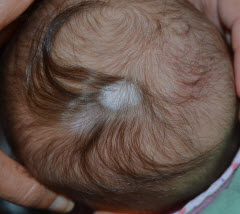(BMJ) - A 46-yo woman w/ MS presented w/ discolored fingers, ulcerations, and necrosis in her left hand. Vasculitis antibodies and complement were normal. Angiography showed distal vasoconstriction. What drug was implicated in her Raynaud phenomenon?

|
Teriflunomide
|
|
Natalizumab
|
|
Glatiramer acetate
|
|
Interferon β1b
|
|
Fingolimod
|
(BMJ) – An otherwise healthy 2-mo-old infant presented w/ 2 adjacent oval patches on the scalp, 2 x 3 cm in diameter, covered by a thin, atrophic membrane. The larger lesion exhibited the “hair collar sign.” MRI of the brain was normal. What is the diagnosis?

|
Cradle cap
|
|
Histiocytosis X
|
|
Atopic dermatitis
|
|
Tinea capitis
|
|
Aplasia cutis congenita (ACC)
|
